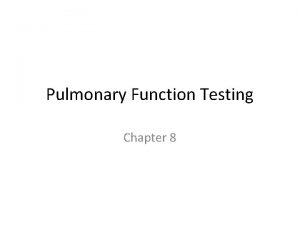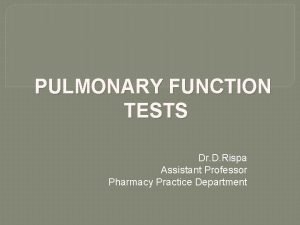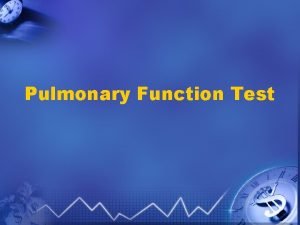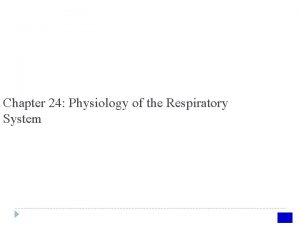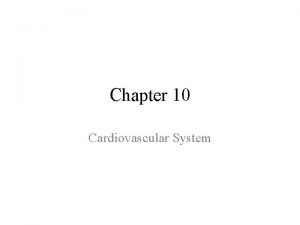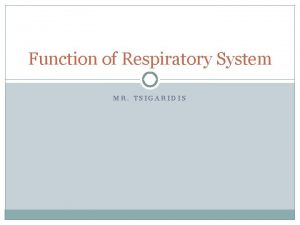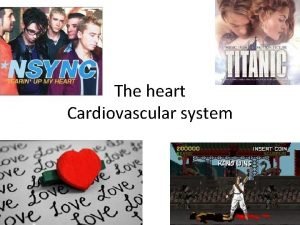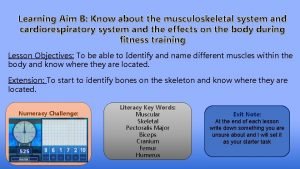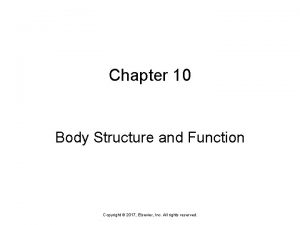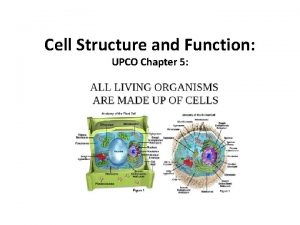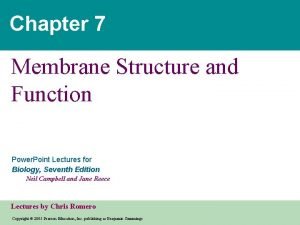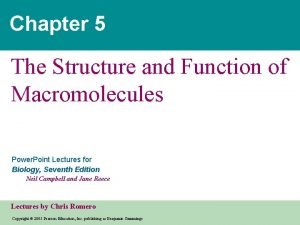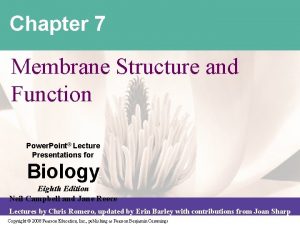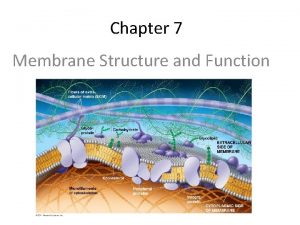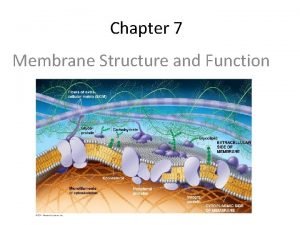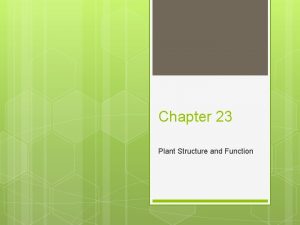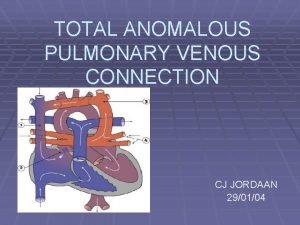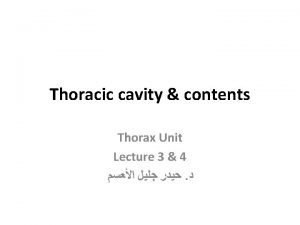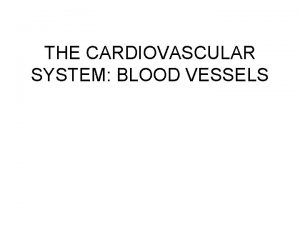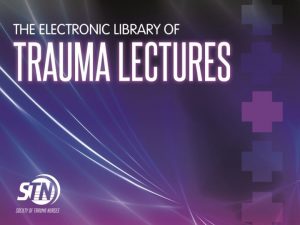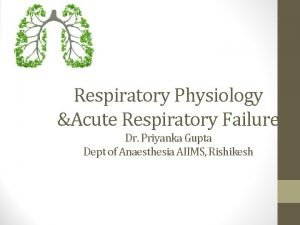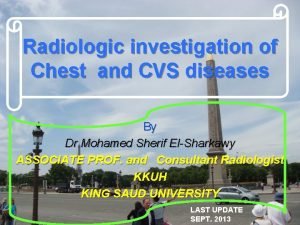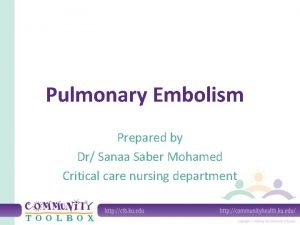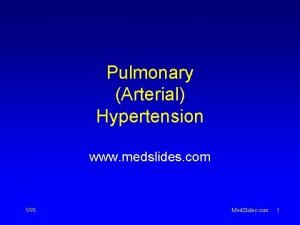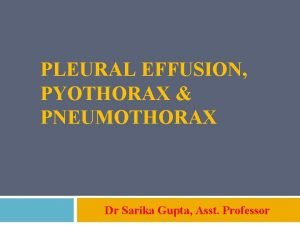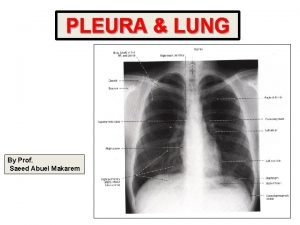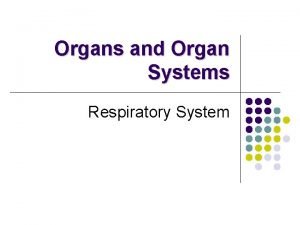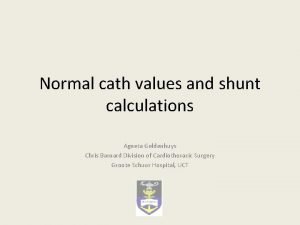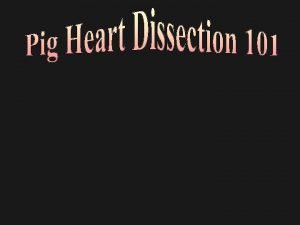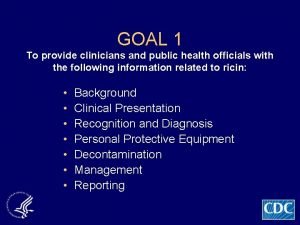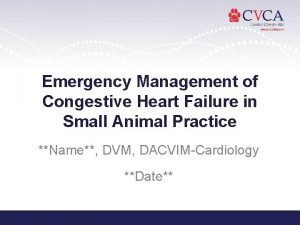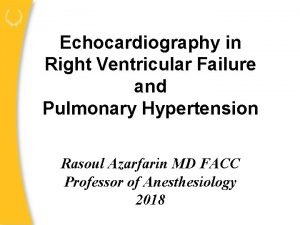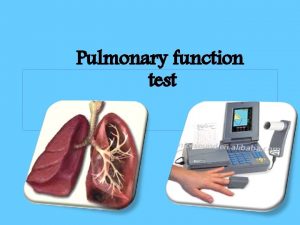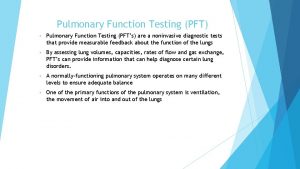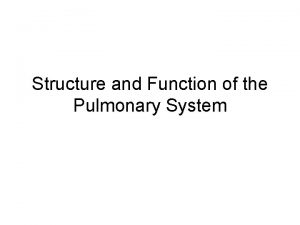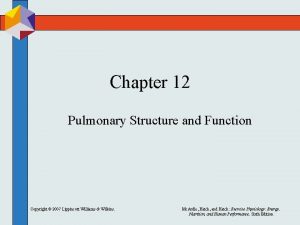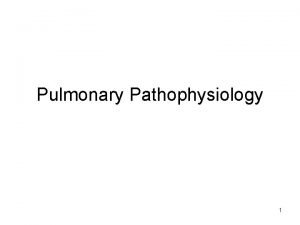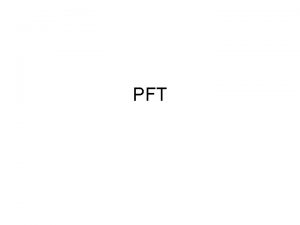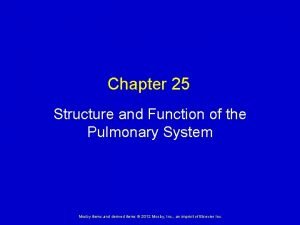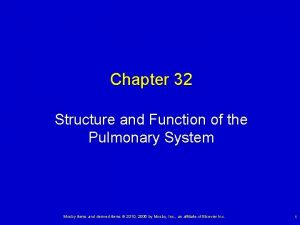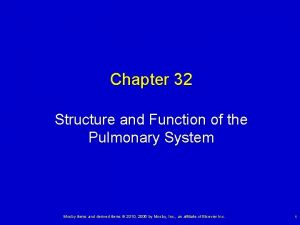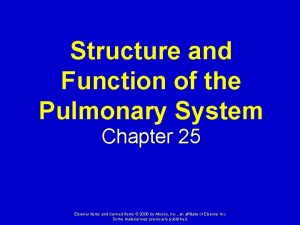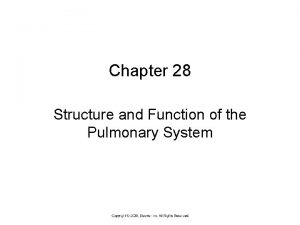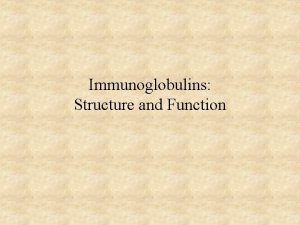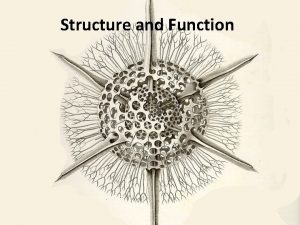Chapter 12 Pulmonary Structure and Function Copyright 2015















































- Slides: 47

Chapter 12 Pulmonary Structure and Function Copyright © 2015 Wolters Kluwer Health | Lippincott Williams & Wilkins

Chapter Objectives u Diagram and label the main structures of the ventilatory system components u Describe the ventilatory system’s conducting, transitional, and respiratory zones u Discuss the mechanical and muscular aspects of inspiration and expiration during rest and physical activity u Define and quantify static and dynamic lung function measures at rest and exercise Copyright © 2015 Wolters Kluwer Health | Lippincott Williams & Wilkins

Chapter Objectives, cont. u Describe two effects of cold-weather exercise on the respiratory tract u Discuss the contributions of breathing rate and tidal volume to minute ventilation and alveolar minute ventilation at rest and physical activity u Discuss two factors that account for variations in the ventilation–perfusion ratio among healthy individuals Copyright © 2015 Wolters Kluwer Health | Lippincott Williams & Wilkins

Chapter Objectives, cont. u Explain the four phases of the Valsalva and discuss the physiologic consequences of this maneuver u Define minute ventilation, alveolar ventilation, ventilation perfusion ratio, and anatomic and physiologic dead space Copyright © 2015 Wolters Kluwer Health | Lippincott Williams & Wilkins

Anatomy of Ventilation • Pulmonary ventilation moves and exchanges ambient air with air in the lungs • Ambient air enters the nose and mouth trachea (and adjusts to body temperature), is filtered and humidified two bronchioles alveoli Copyright © 2015 Wolters Kluwer Health | Lippincott Williams & Wilkins

Pulmonary Structures in the Thoracic Cavity Copyright © 2015 Wolters Kluwer Health | Lippincott Williams & Wilkins

The Lungs • Provide the gas exchange surface that separates blood from surrounding gaseous environment • O 2 transfers from alveolar air into alveolar capillary blood while the blood’s CO 2 moves into the alveolar the alveoli and then into ambient air • An average-sized adult’s lung weighs about 1 kg with a volume of 4 to 6 L § The lungs consists of 10% solid tissue, with the remainder filled with air and blood Copyright © 2015 Wolters Kluwer Health | Lippincott Williams & Wilkins

The Alveoli • More than 600 million alveoli provide the surface for gas exchange between lung tissue and blood • Alveoli receive the largest blood supply of all organs • Capillaries and alveoli lie side-by-side with thin surfaces to facilitate rapid gas exchange • Pores of Kohn within alveoli evenly disperse surfactant over respiratory membranes to reduce surface tension for easier alveolar inflation • Each minute at rest, 250 m. L O 2 leave the alveoli and enter the blood and 200 m. L CO 2 diffuse in the opposite direction Copyright © 2015 Wolters Kluwer Health | Lippincott Williams & Wilkins

Ventilation Mechanics Copyright © 2015 Wolters Kluwer Health | Lippincott Williams & Wilkins

Zones of Ventilation 1. Ventilatory subdivisions § Conducting zones: Trachea and terminal bronchioles - Considered anatomic dead space - Function in air transport, humidification, warming, particle filtration, vocalization, immunoglobulin secretion § Transitional and respiratory zones: Bronchioles, alveolar ducts, and alveoli - Function in gas exchange, surfactant production, molecule activation and inactivation, blood clotting regulation, and endocrine function Copyright © 2015 Wolters Kluwer Health | Lippincott Williams & Wilkins

Zones of Ventilation, cont. • More than 600 million alveoli provide the surface for gas exchange between lung tissue and blood Copyright © 2015 Wolters Kluwer Health | Lippincott Williams & Wilkins

Lung Airflow Related to Total Cross-sectional Tissue Area • Forward airflow velocity during inspiration decreases because of the large increase in tissue crosssectional area in the terminal bronchiole region Copyright © 2015 Wolters Kluwer Health | Lippincott Williams & Wilkins

Fick’s Law of Diffusion • Governs gas diffusion across a fluid membrane § Gas diffuses through a sheet of tissue at a rate: - directly proportional to tissue area, a diffusion constant, and pressure differential of the gas on each side of the membrane - inversely proportional to tissue thickness • The pressure differential between air in the lungs and lung–chest wall interface causes lungs to adhere to the chest wall and follow its every movement Copyright © 2015 Wolters Kluwer Health | Lippincott Williams & Wilkins

Inspiration • Phases: § Diaphragm contracts, flattens, and moves downward toward the abdominal cavity § Elongation and enlargement of the chest cavity expands air in the lungs, causing its intrapulmonic pressure to decrease slightly below atmospheric pressure § Lungs inflate as nose and mouth suck air inward § Completed when thoracic cavity expansion ceases; this causes equality between intrapulmonic and ambient atmospheric pressures Copyright © 2015 Wolters Kluwer Health | Lippincott Williams & Wilkins

Expiration • The passive process during rest and light exercise as air moves out of lungs from: § Natural recoil of stretched lung tissue and relaxation of inspiratory muscles • Expiration Phases § Sternum and ribs drop, diaphragm rises (decreasing chest cavity volume and compressing alveolar gas), moving air from respiratory tract to the environment § Completes when compressive force of expiratory muscles (activated in vigorous exercise) cease and intrapulmonic pressure decreases to atmospheric pressure Copyright © 2015 Wolters Kluwer Health | Lippincott Williams & Wilkins

Surfactant (Surface Active Agent) • “Wetting agent” lipoprotein mixture of proteins, phospholipids, and calcium ions produced by alveolar epithelial cells (to reduce surface tension) § Mixes with fluids encircling alveolar chambers • Interrupts the surrounding water layer, reducing the alveolar membrane’s surface tension, thereby increasing overall lung compliance • Reduces the energy required for alveolar inflation and deflation • Without surfactant, small alveoli would collapse (atelectasis ) from high collapsing pressures Copyright © 2015 Wolters Kluwer Health | Lippincott Williams & Wilkins

Lung Volumes and Capacities: Static Lung Volumes • Tidal volume: Air moved during the inspiratory or expiratory phase of each breathing cycle (0. 4 to 1. 0 L of air per breath) • Inspiratory reserve volume: Inspiring as deeply as possible following a normal inspiration (2. 5 to 3. 5 L above inspired tidal air) • Expiratory reserve volume: After a normal exhalation, continuing to exhale and forcing as much air as possible from the lungs (1. 0 to 1. 5 L) • Forced vital capacity: Total volume of air voluntarily moved in one maximal breath; it includes TV plus IRV and ERV (4 to 5 L in young men) and (3 to 4 L) in young women Copyright © 2015 Wolters Kluwer Health | Lippincott Williams & Wilkins

Static Measures of Lung Volume Copyright © 2015 Wolters Kluwer Health | Lippincott Williams & Wilkins

Residual Lung Volume • Air volume remaining in the lungs after a forced maximal exhalation § Averages 0. 8 to 1. 2 L for healthy college-aged women, and 0. 9 to 1. 4 L for college-aged men § Increases with age • Allows an uninterrupted exchange of gas between the blood and alveoli to prevent fluctuations in blood gases during phases of the breathing cycle • RLV plus FVC = total lung capacity (TLC) Copyright © 2015 Wolters Kluwer Health | Lippincott Williams & Wilkins

Effects of Previous Exercise Effects on RLV • RLV temporarily increases from an acute bout of either short-term or prolonged exercise due to: § Closure of small peripheral airways § Increase in thoracic blood volume Copyright © 2015 Wolters Kluwer Health | Lippincott Williams & Wilkins

Dynamic Lung Volumes • Dynamic pulmonary ventilation depends on: § Maximum “stroke volume” of the lungs (FVC) § Speed of moving a volume of air (breathing rate) - Determined by lung compliance (the resistance of respiratory passages to air movement and “stiffness” imposed by the chest and lung tissues) Copyright © 2015 Wolters Kluwer Health | Lippincott Williams & Wilkins

FEV-to-FVC Ratio • Forced expiratory volume (FEV) § Maximal airflow measured over 1 s (FEV 1. 0) § FEV 1. 0 ÷ FVC indicates pulmonary airflow capacity § Reflects pulmonary expiratory power and overall resistance to air movement upstream in lungs § FEV 1. 0 ÷ FVC = ~85% in healthy individuals § FEV 1. 0 ÷ FVC ≤ 70% = delineation point for airway obstruction Copyright © 2015 Wolters Kluwer Health | Lippincott Williams & Wilkins

Examples of Pulmonary Function Tests in Normal Subjects and in Patients with Obstructive or Restrictive Lung Disease Copyright © 2015 Wolters Kluwer Health | Lippincott Williams & Wilkins

Maximum Voluntary Ventilation (MVV) • Evaluates ventilatory capacity with rapid and deep breathing for 15 s § Extrapolated to volume if continued for 1 min § MVV typically ranges between 35 to 40 times FEV 1. 0 • MVV ranges between 140 and 180 L/min in healthy, college -age men, and 80 and 120 L/min in healthy, college-age women • Exercise training of the ventilatory muscles improves their strength and endurance, increasing inspiratory muscle function and MVV Copyright © 2015 Wolters Kluwer Health | Lippincott Williams & Wilkins

Physical Activity Implications of Gender Differences in Static and Dynamic Lung Function Measures • Compared to men, women have a reduced lung size and airway diameter, a smaller diffusion surface, and lower static and dynamic lung function measures § Leads to expiratory flow limitations, greater respiratory muscle work and use of ventilatory reserve during maximal exercise (particularly in highly trained women) § A smaller lung volume plus a high expiratory flow rate demands in trained women during intense exercise places considerable demand on maximum flow–volume envelope of the airways; this adversely affects the maintenance of alveolar-to-arterial oxygen exchange Copyright © 2015 Wolters Kluwer Health | Lippincott Williams & Wilkins

Lung Function, Aerobic Fitness, and Physical Performance • Regular endurance exercise does not stimulate large increases in pulmonary system functional capacity • Dynamic lung function tests indicate severity of obstructive and restrictive lung diseases, but provide little information about aerobic fitness or exercise performance when values fall within the normal range Copyright © 2015 Wolters Kluwer Health | Lippincott Williams & Wilkins

Pulmonary Ventilation • Can be viewed from two perspectives: 1. Volume of air moved into or out of the respiratory tract each minute 2. Air volume that ventilates only alveolar chambers each minute Copyright © 2015 Wolters Kluwer Health | Lippincott Williams & Wilkins

Minute Ventilation (VE) • The volume of air breathed each minute VE = Breathing rate × Tidal volume - can be increased by an increase in breathing rate or breathing depth, or both - breathing rate can increase to 35 to 45 breaths/min during strenuous exercise in healthy young adults and 60 to 70 breaths/min in some elite endurance athletes § Tidal volume for trained and untrained individuals rarely exceed 60% of vital capacity Copyright © 2015 Wolters Kluwer Health | Lippincott Williams & Wilkins

Alveolar Ventilation • Anatomic dead space: air in each breath that does not enter alveoli and participate in gaseous exchange with blood (range 150 to 200 m. L) • Alveolar ventilation: portion of inspired air reaching the alveoli and participating in gas exchange § Determines the gaseous concentrations at the alveolar–capillary membrane § About 350 m. L of the 500 m. L of inspired TV at rest enters into and mixes with existing alveolar air Copyright © 2015 Wolters Kluwer Health | Lippincott Williams & Wilkins

Typical Values for Pulmonary Ventilation During Rest and Physical Activity Breathing Rate (Breaths ∙ min− 1) Tidal Volume (L ∙ min− 1) Pulmonary Ventilation (L ∙ min− 1) Rest 12 0. 5 6 Moderate exercise 30 2. 5 75 Intense exercise 50 3. 0 150 Condition Copyright © 2015 Wolters Kluwer Health | Lippincott Williams & Wilkins

Dead Space Versus Tidal Volume • Anatomic dead space increases as TV becomes larger; it often doubles during deep breathing from stretching of respiratory passages with a fuller inspiration • Any increase in dead space represents proportionately less volume than the increase in TV § Deeper breathing provides more effective alveolar ventilation than similar minute ventilation achieved through increased breathing rate Copyright © 2015 Wolters Kluwer Health | Lippincott Williams & Wilkins

Ventilation-Perfusion (V-P) Ratio • The ratio of alveolar ventilation to pulmonary blood flow § ~4. 2 L of air ventilates alveoli each min at rest and ~5. 0 L of blood flows through pulmonary capillaries each min § Average V-P Ratio = 0. 84 - An alveolar ventilation of 0. 84 L matches each liter of pulmonary blood flow § In light exercise, V-P Ratio remains ~0. 8 L § In intense exercise V-P Ratio = 5. 0 L Copyright © 2015 Wolters Kluwer Health | Lippincott Williams & Wilkins

Physiologic Dead Space • The portion of the alveolar volume with a ventilation– perfusion ratio that approaches zero § Sometimes alveoli may not function adequately in gas exchange because of two factors: - Underperfusion of blood - Inadequate ventilation relative to alveolar surface • In certain pathologic conditions, physiologic dead space increases to 50% of TV • Adequate gas exchange becomes impossible when dead space of the lung exceeds 60% TLV Copyright © 2015 Wolters Kluwer Health | Lippincott Williams & Wilkins

Distribution of Tidal Volume • TV includes about 350 m. L of ambient air mixed with alveolar air, 150 m. L ambient air remaining in air passages (anatomic dead space), and a small portion of air in the physiologic dead space Copyright © 2015 Wolters Kluwer Health | Lippincott Williams & Wilkins

Breathing Rate Versus Tidal Volume • Increasing the rate and depth of breathing increases alveolar ventilation in physical activity • In moderate activity, well-trained athletes maintain alveolar ventilation by increasing TV with only a small increase in breathing rate § In exercise, breathing becomes deeper and alveolar ventilation increases from 70% at rest to >85% of exercise minute ventilation • Each person develops their “style” of breathing; breathing rate and TV blend to provide effective alveolar ventilation Copyright © 2015 Wolters Kluwer Health | Lippincott Williams & Wilkins

Pulmonary Volumes and Capacities During Rest and Exercise Copyright © 2015 Wolters Kluwer Health | Lippincott Williams & Wilkins

Variations from Normal Breathing Patterns • Hyperventilation § Increase in pulmonary ventilation that exceeds the O 2 consumption and CO 2 elimination needs of metabolism • Dyspnea § Inordinate shortness of breath or subjective breathing distress • Valsalva Maneuver § Closing glottis following a full inspiration while maximally activating expiratory muscles, creating compressive forces that increase intrathoracic pressure above atmospheric pressure - Occurs commonly in activities that require a rapid, maximum application of force for short duration Copyright © 2015 Wolters Kluwer Health | Lippincott Williams & Wilkins

Physiologic Consequences of Performing the Valsalva Maneuver • Performing a prolonged Valsalva maneuver during static, straining-type exercise dramatically reduces venous return and arterial blood pressure § Diminishes brain’s blood supply, producing dizziness or fainting § Once the glottis reopens and intrathoracic pressure normalizes, blood flow reestablishes with an “overshoot” in arterial blood pressure - Does not cause the large increases in blood pressure during heavy resistance exercises; these exercises greatly increase resistance to blood flow in active muscle with a resulting rise in systemic blood pressure Copyright © 2015 Wolters Kluwer Health | Lippincott Williams & Wilkins

Valsalva Maneuver • Valsalva reduces return of blood to the heart because increased intrathoracic pressure collapses inferior vena cava that runs through the chest cavity Normal breathing Straining exercise with Valsalva Copyright © 2015 Wolters Kluwer Health | Lippincott Williams & Wilkins

Valsalva Maneuver, cont. • Valsalva reduces return of blood to the heart because increased intrathoracic pressure collapses inferior vena cava that runs through the chest cavity Normal aortic pulse pressure with Valsalva during calibrated muscle strain Copyright © 2015 Wolters Kluwer Health | Lippincott Williams & Wilkins

Respiratory Tract During Cold-Weather Activity • Cold ambient air normally does not damage respiratory passages because of relatively rapid airway warming § This air-conditioning process greatly increases air’s capacity to hold moisture, which produces measurable water loss from the respiratory passages § In cold weather, the respiratory tract loses considerable water and heat, especially during strenuous exercise • Fluid loss from the airways contributes to dehydration, dry mouth, burning sensation in the throat, and generalized irritation of the respiratory passages Copyright © 2015 Wolters Kluwer Health | Lippincott Williams & Wilkins

Summary 1. The lungs provide a large surface between the body’s internal fluid environment and the gaseous external environment. During any 1 s of physical activity, no more than 1 pint of blood flows in the pulmonary capillaries. 2. Fick’s law of diffusion governs gas movement across a fluid membrane 3. Surfactant consists of a lipoprotein mixture secreted within lung tissue that reduces surface tension between the alveolar membrane and surrounding tissues Copyright © 2015 Wolters Kluwer Health | Lippincott Williams & Wilkins

Summary, cont. 4. Pulmonary airflow depends on small pressure differentials between ambient air and air within the lungs. Ventilatory muscle action produces these pressure differences 5. Lung volumes vary with age, gender, and body size (particularly stature) 6. The residual lung volume represents air remaining in the lungs following maximal exhalation 7. FEV and MVV dynamically measure the ability to sustain a high airflow level Copyright © 2015 Wolters Kluwer Health | Lippincott Williams & Wilkins

Summary, cont. 8. Measures of static and dynamic lung function within the normal range poorly predict aerobic fitness and exercise performance 9. Breathing rate and tidal volume (TV) determine pulmonary minute ventilation 10. Alveolar ventilation reflects the portion of minute ventilation that enters the alveoli for gaseous exchange with the blood 11. The ventilation–perfusion ratio reflects the association between alveolar minute ventilation and pulmonary blood flow Copyright © 2015 Wolters Kluwer Health | Lippincott Williams & Wilkins

Summary, cont. 12. TV increases during physical activity by encroachment into inspiratory and expiratory reserve volumes 13. During intense exercise, TV plateaus at approximately 60% of the vital capacity; minute ventilation increases further through increases in breathing rate Copyright © 2015 Wolters Kluwer Health | Lippincott Williams & Wilkins

Summary, cont. 14. A Valsalva maneuver describes a forced exhalation against a closed glottis, which causes large pressure increases within the chest and abdominal cavities that compress the thoracic veins (thereby reducing venous return to the heart) 15. Breathing cold ambient air normally does not damage respiratory passage Copyright © 2015 Wolters Kluwer Health | Lippincott Williams & Wilkins

Image Sources Slide 12: Adapted with permission from West JB. Respiratory Physiology—The Essentials. 8 th ed. Baltimore: Lippincott Williams & Wilkins, 2008. Slide 40: Data from Hébert J-L, et al. Pulse pressure response to the strain of the Valsalva maneuver in humans with preserved systolic function. J Appl Physiol 1998; 85: 817. Copyright © 2015 Wolters Kluwer Health | Lippincott Williams & Wilkins
 Copyright 2015 all rights reserved
Copyright 2015 all rights reserved Copyright © 2015 all rights reserved
Copyright © 2015 all rights reserved Pulmonary surfactant function
Pulmonary surfactant function Pulmonary loop
Pulmonary loop Pft test meaning
Pft test meaning Frc pft
Frc pft Pulmonary gas exchange and transport diagram
Pulmonary gas exchange and transport diagram Pulmonary artery and aorta
Pulmonary artery and aorta Bronchial circulation and pulmonary circulation
Bronchial circulation and pulmonary circulation Pulmonary ventilation consists of two cyclic phases
Pulmonary ventilation consists of two cyclic phases Aorta inferior vena cava
Aorta inferior vena cava Aorta and pulmonary artery
Aorta and pulmonary artery Aorta and pulmonary artery
Aorta and pulmonary artery Blood circulation system diagram
Blood circulation system diagram Pulmonary volumes and capacities
Pulmonary volumes and capacities Chapter 10 body structure and function
Chapter 10 body structure and function Biology chapter 7 cell structure and function
Biology chapter 7 cell structure and function Chapter 22 plant structure and function answer key
Chapter 22 plant structure and function answer key Chapter 7 cell structure and function section review 7-2
Chapter 7 cell structure and function section review 7-2 Chapter 5 cell structure and function
Chapter 5 cell structure and function Chapter 7 membrane structure and function
Chapter 7 membrane structure and function Chapter 5 the structure and function of macromolecules
Chapter 5 the structure and function of macromolecules Chapter 21 plant structure and function
Chapter 21 plant structure and function Chapter 7 membrane structure and function
Chapter 7 membrane structure and function Flaccid cell
Flaccid cell Chapter 7 membrane structure and function
Chapter 7 membrane structure and function Section 23-4 leaves
Section 23-4 leaves Tapvc
Tapvc Define thoracic cavity
Define thoracic cavity Systemic circulation
Systemic circulation Neurogenic shock pathophysiology
Neurogenic shock pathophysiology Heart
Heart Blood gas
Blood gas Hypoinspiratory
Hypoinspiratory Westermark sign
Westermark sign Pulmonary embolism shock
Pulmonary embolism shock Medslide
Medslide Pleural friction rub
Pleural friction rub Mediastinal surface
Mediastinal surface Windpipe cells
Windpipe cells Pulmonary vascular resistance normal range
Pulmonary vascular resistance normal range Pulmonary toilet
Pulmonary toilet Pulmonary edema
Pulmonary edema Sheep heart
Sheep heart Cardiorespiratory failure
Cardiorespiratory failure Cardiac vs pulmonary dyspnea
Cardiac vs pulmonary dyspnea Normal pulmonary artery pressure
Normal pulmonary artery pressure Pulmonary hypertension severity
Pulmonary hypertension severity



